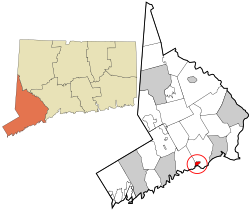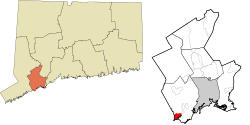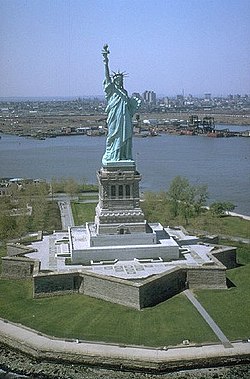Southport, Connecticut
 From Wikipedia - Reading time: 17 min
From Wikipedia - Reading time: 17 min
Southport | |
|---|---|
 Southport Harbor seen from neighboring Sasco Hill | |
| Coordinates: 41°7′55″N 73°17′4″W / 41.13194°N 73.28444°W | |
| Country | |
| U.S. state | Connecticut |
| County | Fairfield |
| Region | CT Metropolitan |
| Town | Fairfield |
| Settled | 1639 |
| Incorporated (borough) | 1831 |
| Disincorporated | 1854 |
| Area | |
• Total | 0.992 sq mi (2.57 km2) |
| • Land | 0.858 sq mi (2.22 km2) |
| • Water | 0.134 sq mi (0.35 km2) |
| Population (2020) | |
• Total | 1,710.[1] |
| • Summer (DST) | EDT |
| ZIP Code | 06890 |
| Area code | 203/475 |
| FIPS code | 09-71040 |
| GNIS feature ID | 2631576[2] |
Southport is a census-designated place (CDP) in the town of Fairfield, Connecticut, United States. It is located along Long Island Sound between Mill River and Sasco Brook, where it borders Westport. As of the 2020 census, it had a population of 1,710.[3] Settled in 1639, Southport center has been designated a local historic district since 1967. In 1971, it was listed on the National Register of Historic Places as the Southport Historic District.
History
[edit]
The indigenous village of Sasqua, inhabited by Quiripi language speakers, was located in the area. Members of that community later formed the Golden Hill Paugussett Indian Nation.
The earliest recorded event in Southport's history was "The Great Swamp Fight" or "Fairfield Swamp Fight" of July 1637 (not to be confused with the later Great Swamp Fight of King Philip's War), an episode of the Pequot War in which English colonial forces led by John Mason and Roger Ludlow vanquished a band of 80 to 100 Pequot Indians who had earlier fled from their home territory in the Mystic area and taken refuge with approximately 200 Sasqua Indians who inhabited the area that is now Fairfield. The exact location of the battle is unclear, but it is known to have been in the vicinity of Southport.[4] In 1639, Ludlow established the town of Fairfield on the Pequot land known as Unquowa. Colonial deeds of land were signed with the Sasqua in the 1670s.[5]
In the eighteenth century, Mill River village, a part of Fairfield, was a small hamlet of a few houses and a wharf at the mouth of Fairfield's Mill River. Farm products from the surrounding area were shipped from Mill River's small harbor to ports in New York and beyond.[6]

By 1831 the village had changed its name to Southport and was a bustling commercial area with warehouses, churches, schools, stores and elegant houses. Before 1853, Southport had its own local government as a borough within the town of Fairfield.[7]
Economic history
[edit]
Southport became a leading coastal port on Long Island Sound, its ships carrying produce and goods back and forth to New York City. A measure of Southport's success is the fact that throughout the 1800s it possessed the only two banks in town. However, competition from steamboats and the railroad took their toll on prosperity. Resourceful shippers teamed with local farmers and businessmen to keep the port going.
The Southport Onion, a high quality onion, was developed and grown on Westport's and Fairfield's hills and shipped in Southport market boats. These boats were mostly sloops that carried 50 tons and more in some cases of cargo [8] keeping the harbor profitable until the end of the century. The federal government supported repairs to the harbor in the 1840s.[9] During the 1840s, the greatest agricultural innovation in Fairfield became the cultivation of onions.[10] From 1840 to 1890, 200,000 tons yearly were shipped out of Southport. Designed to be easily stored, during the Civil War sales spiked, its high vitamin C content prized by the U.S. Navy to prevent scurvy.[11] The U.S. Army prized it to treat gunshot wounds, at one point to the extent that General Ulysses S. Grant refused to move his troops if they were not supplied with onions.[12]
In the 1890s, 100,000 barrels of locally grown onions, carrots, potatoes, and other goods were shipped annually from Southport harbor.[6]

The shipping industry was the economic foundation of the village of Mill River. The village, as it became a large port, eventually changed its name to South Port, later Southport. Local farmers transported their Southport Globe onions and other crops via the growing shipping fleet housed in the harbor and, by 1836, it became larger than the New York City and Boston ports. The ships sailed to destinations as far as the West Indies, but often went to New York City, where larger vessels in a deeper port headed to more distant foreign destinations. During the period from 1750 to 1900, the shipping industry grew dramatically, but died out as the railroad industry and steamship industries took over. The increased use of large shipping containers also decreased transport costs and eventually drove the need to use ports deeper than Southport Harbor. The local produce was transported to New York and Boston via train, to deeper water ports where larger vessels were docked.[13]
Local Sea Captains
[edit]
During the peak of the shipping era, Southport had four shipyards in old Mill River, and many of Southport's first families built their wealth in the lucrative shipping trade that grew in response to local farmers wanting a more convenient port than Bridgeport and Norwalk Harbors. Numerous area parks and streets are named after prominent sea captains, including Bulkley Avenue, Sherwood Island State Park, and Sturges Highway. Capt. Zalman Wakeman owned Wakeman Farms, which is still operating today.[14]
Preservation
[edit]Today, much of the old village area is part of a town historic district, first established in 1967, where buildings from three centuries are protected for future generations. The boundaries of the town historic district are the railroad on the north; the Mill River and Southport Harbor on the south; Church Street; and Old South Road and Rose Hill Road on the west and east, respectively, including all properties on both sides of the roads.[15] Strict historic zoning regulations apply in the district and have been upheld by the Connecticut Supreme Court.[15][16] The Southport Historic District is also listed on the National Register of Historic Places.
Architecture
[edit]Southport is home to one of the finest collections of historic residences and institutional buildings in New England. Southport Village was selected as a Connecticut Historical District in 1966, and a National Historic District in 1971.[17] As a result, the Village serves as a time capsule of sorts, perfectly preserving a wide variety of very different architectural styles. Ranging from the 1760s to the 1890s, architectural styles reflected include: Greek Revival, Federal, Queen Anne, Italianate, Stick Style, and more. [17]
Many of these buildings were constructed by local firm Jelliff and Northrop, with several designed by noted architectural firm Bunnell & Lambert.[18]
-
Gurdon Perry House, Federal style (1830)
-
Henry Perry House, Greek Revival (1832)
-
Francis Perry House, Greek Revival (1832)
-
Southport Savings Bank, Italianate (1863)
-
Austin Perry House, Greek Revival (1835)
-
Captain Wakeman B. Meeker House (1857)
-
Oliver Bulkley House (1861), Lambert & Bunnell, Gothic Revival
-
Mrs. Benjamin Pomeroy House (1868), Lambert & Bunnell, Second Empire Style
Geography
[edit]According to the United States Census Bureau, Southport has a total area of 1.338 square miles (3.47 km2), of which 1.191 square miles (3.08 km2) is land and 0.147 square miles (0.38 km2), or 10.99%, is water.[19]
Demographics
[edit]
The village of Southport corresponds to census tract 606. As of the census[20] of 2020, there were 1,710 people in the village, organized into 798 households. The racial makeup of the town was 87% White, 5% Hispanic or Latino of any race, 4% African American, 2% Asian, 0% Native American, and 2% identifying as two or more races. .
Households averaged 2.1 persons, with 66% consisting of married couples, 7.3% of female householders with no husband present, 2.5% of male householders, and 24.4% of people who were not family members. 16% of residents were under the age of 18, 60.1% were between the ages of 18 and 64, and 23.9% were over the age of 65.
The median household income was $180,057, with 9% of households below the poverty line. The median value of homes in the village was $766,900
Public services
[edit]

Southport has had its own firefighting service since 1895. The Southport Fire Department was organized that year as a volunteer fire department after a large arson fire in the village. However, it is also protected by Fairfield Fire Department's Engine 4, out of the Southport Firehouse.[21]
The neighborhood's ZIP Code is 06890, whose scope extends further north from the historic village area to include the Mill Hill area.
Library
[edit]The community's public library is the Pequot Library, an independently owned and operated special collections library, founded by Virginia Marquand Monroe and Elbert Monroe in 1887. A Richardsonian Romanesque building, it was designed by the architect Robert Henderson Robertson and is a contributing property to the National Register Southport Historic District.[22]
The library has a large collection of manuscripts, rare books, and archives.[7] Of the approximate 30,000 items in the Special Collections,1800 items are held on long-term loan at the Beinecke Rare Book and Manuscript Library at Yale University.
The collection at Pequot Library includes the first printed cookbook, De Honesta Voluptate et Valetudine,by Bartholomaeus Platina (1475); autographs of all American Presidents and the cosigners of the Declaration of Independence, including the rare Button Gwinnett autograph. Among the titles in the Special Collections are Epistola de insulis nuper inventis by Christopher Columbus, translated into Latin by Leandro di Cosco and printed in 1493; two of the three contemporaneous histories of the Pequot War in New England; the Saybrook Platform which was the first book published in Connecticut in 1710.[23] Also included in the collection is Phillis Wheatley's Poems on various subjects, religious and moral from 1786 as well as the typescript of the last four chapters of Margaret Mitchell's Gone With the Wind.[24]
The library's annual summer book sale featured more than 140,000 volumes on sale in 2007.[25] In 2006, the Pequot Library invested in a restoration project to address the condition of the elaborate metalwork set throughout their stacks. Robert Robertson designed each shelf in the library to be supported by cast iron structures. Each row of shelving is framed by columns and the stairways linking the two stories are made with balusters of garlands and vines in copper plated cast iron. During the course of restoration, over 6,000 metal pieces were individually treated. The project was carried out by Newmans’ Ltd.[26]
 |
 |
Education
[edit]Eagle Hill School-Southport, a private day school for children with learning disabilities, has been located since 1985 in the former Pequot School in Southport. The historic school building was earlier acquired by the Southport Conservancy to save it from demolition.[27][28]
Southport is served by the Fairfield Public Schools. Southport is home to Mill Hill Elementary School, although children in some areas considered part of the Southport neighborhood but outside the census tract attend Timothy Dwight Elementary School. Both Mill Hill and Dwight Schools feed into Roger Ludlowe Middle School, Tomlinson Middle School and Fairfield Ludlowe High School.[29]
Transportation
[edit]
The main arterial road in the area, the Post Road (US Route 1), runs through Southport, connecting it to other towns along the Connecticut coast. Interstate 95 also passes through Southport, with two exits located in the neighborhood. Southport is also served by the New Haven Line of the Metro-North Commuter Railroad at Southport Railroad Station, with frequent trains to New Haven and New York City.[30] Limited bus service is provided by the Greater Bridgeport Transit Authority.
Notable people
[edit]
The following are among the notable people who have lived in Southport:
- James Truslow Adams, historian and writer
- John Akers, former chief executive officer of IBM[7]
- Anatole Broyard, author[7]
- Ina Garten, celebrity cook and author
- Jeffrey Garten, economic adviser and author
- Don Imus, radio personality
- Richard Clarida, Vice Chairman of the Federal Reserve, Economist
- Kenton Clarke, CEO, Computer Consulting Associates International Inc.
- Ruth Madoff, widow of Bernie Madoff[31]
- Samuel J. Palmisano, former chief executive officer of IBM
- Jason Robards, actor, producer and director[7]
- Stokely Webster, impressionist painter[32]
- Jack Welch, former CEO General Electric
Movies filmed in Southport
[edit]- Revolutionary Road (2007)
- And So It Goes (2014)
References
[edit]- ^ "Explore Census Data". Retrieved July 5, 2022.
- ^ U.S. Geological Survey Geographic Names Information System: Southport, Connecticut
- ^ "Search Results". The United States Census Bureau. United States Census Bureau. Retrieved June 26, 2022.
- ^ "Fairfield Museum and History Center". www.fairfieldhs.org. Archived from the original on July 23, 2008.
- ^ "LIVING IN THE NEW WORLD: Exhibition Guide" (PDF). Pequot Library.
- ^ a b History of the Town of Fairfield, Connecticut
- ^ a b c d e Charles, Eleanor. "If You're Thinking of Living in; Southport", New York Times, December 22, 1985.
- ^ Farnham, Thomas (1988). Fairfield, The Biography of a Community. Phoenix Publishing. p. 153. ISBN 0-914659-37-5.
- ^ Tyler), United States President (1841-1845 (1842). Message to the Two Houses at the Commencement of the Third Session of the Twenty-seventh Congress: Dec. 7, 1842. With the Accompanying Documents.
{{cite book}}: CS1 maint: numeric names: authors list (link) - ^ Farnham, Thomas (1988). Fairfield, The Biography of a Community. Phoenix Publishing. p. 152. ISBN 0-914659-37-5.
- ^ Alexandra, Sefra (July 5, 2022). "The Southport Globe Onion Initiative". seedhuntress.com. Retrieved July 5, 2022.
- ^ Rupp, Rebecca (December 1, 2014). "The Vegetable That Treated Gunshot Wounds". National Geographic. Archived from the original on August 10, 2021. Retrieved July 5, 2020.
- ^ Lacey, Charlotte Alvord (April 6, 1925). An historical story of Southport, Connecticut: 1637-1927 (First ed.). Greens Farms, CT USA: Modern Books and Crafts, Inc. Greens Farms, CT 06436 USA. pp. 42–44.
- ^ Lacey, Charlotte Alvord (April 6, 1925). An Historical Story of Southport, CT (First ed.). Greens Farms, Conn., 06436 USA: Modern Books and Crafts, Inc., Greens Farms, Conn., 06436 USA. pp. 42–43.
{{cite book}}: CS1 maint: location (link) - ^ a b Gibbons v. Fairfield Historic District Commission, 285 Conn. 755; 941 A.2d 917; 2008 Conn. LEXIS 80
- ^ An Enclave for One’s Inner Scarlett, New York Times, June 12, 2009
- ^ a b Cigliano, Jan (January 1, 1989). Southport: The architectural legacy of a Connecticut village. Southport Conservancy.
- ^ "Lambert and Bunnell Architects". Buildings of New England. September 20, 2023. Retrieved March 22, 2024.
- ^ "US Gazetteer files: 2019". United States Census Bureau. Retrieved October 10, 2020.
- ^ "U.S. Census website". United States Census Bureau. Retrieved January 31, 2008.
- ^ Abbreviated History of The Southport Fire Department, Southport Fire Department Corp. website, accessed June 17, 2009
- ^ Economic Development & Affordable Housing, Congressman Jim Himes' website, accessed July 13, 2009
- ^ Charles, Eleanor (September 14, 1980). "Treasures at Pequot". The New York Times. ISSN 0362-4331. Retrieved June 25, 2022.
- ^ McGrath, Charles (March 29, 2011). "A Piece of 'Gone With the Wind' Isn't Gone After All". The New York Times. ISSN 0362-4331. Retrieved June 25, 2022.
- ^ "Calendar" section of The Norwalk Citizen-News, July 27, 2007, p. A35
- ^ Newmans' Ltd. Art Restoration
- ^ History, Eagle Hill-Southport website, accessed October 13, 2009
- ^ Southport Conservancy website, accessed October 13, 2009
- ^ [1], Fairfield Public Schools website, accessed September 1, 2010
- ^ Governor Rell Announces Plan to Rebuild Southport Train Station; Demolition Unnecessary; Building Can Be Salvaged, Connecticut Department of Transportation press release, 2/20/2008
- ^ "Ruth Madoff from Southport, Connecticut | VoterRecords.com". voterrecords.com. Retrieved January 10, 2023.
- ^ "Stokely Webster | Smithsonian American Art Museum". americanart.si.edu. Retrieved March 6, 2024.
External links
[edit]- The Southport Conservancy (organization for preservation and restoration of historic properties in Southport)
- The Southport Globe (a website focused on the community)
- The Southport Picture File (a collection of 800 historical photos compiled by historian V. Louise Higgins. Housed at Pequot Library and accessible online.)
- Living in Southport, Conn. (New York Times photo collection)
- Brilvitch, Charles. 1977. Walking Through History. The Seaports of Black Rock and Southport. Fairfield Historical Society.
 KSF
KSF










